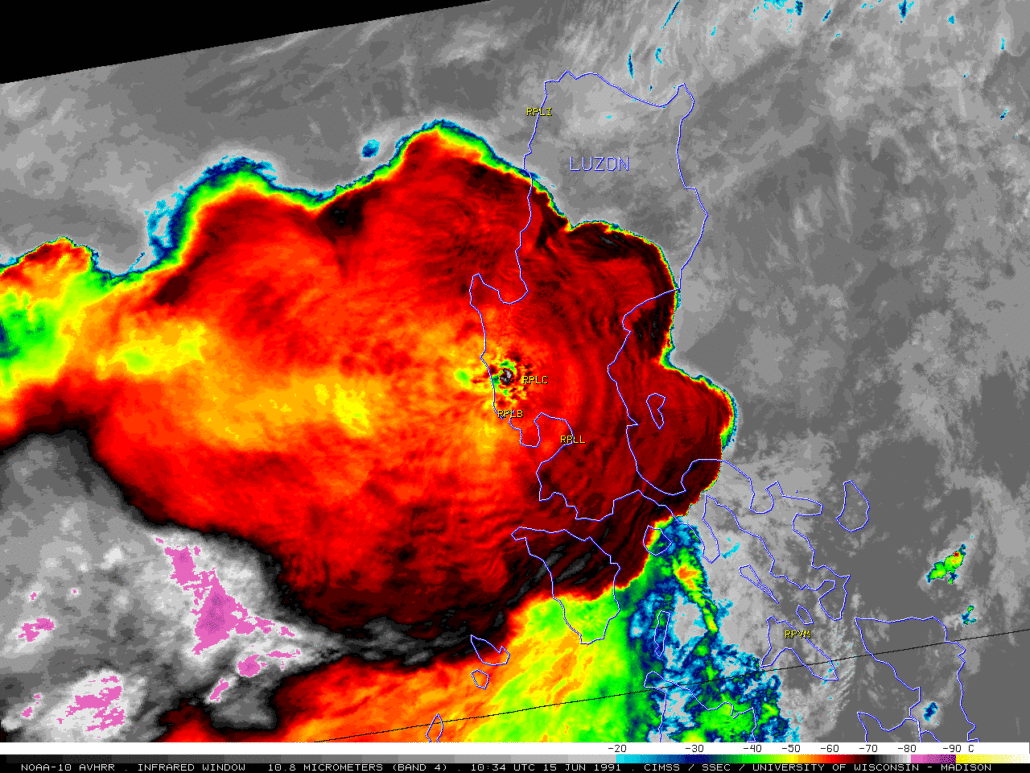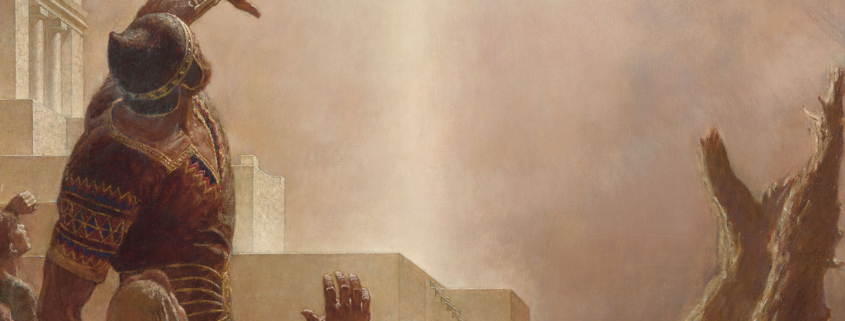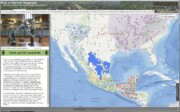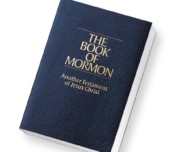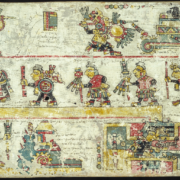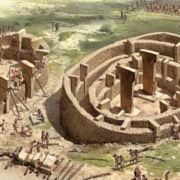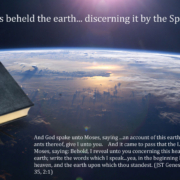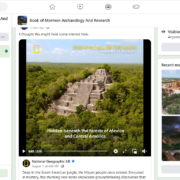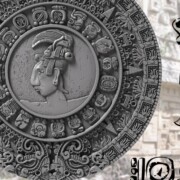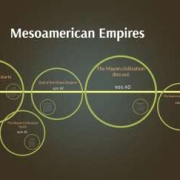Accounts of Destructions & Darkness at Christs Death from Around the World
Long ago in ancient Peru, there was a legend of a time of worldwide darkness. It is said the sun was gone for five days. Stones knocked against one another. Shepherds were attacked by their own sheep whether they were running away in the fields or hiding in their homes. Even the mortars and pestles (grinders and their bowls) are said to have rebelled against their owners.
In another Peruvian story, it is said that there was a people before the Incans. These ancient people experienced a period without light. So they prayed until the sun finally rose from Lake Titicaca, and in the midday, a white man who carried great authority came into the land. He is said to have turned hills into plains, and vice versa. Fountains sprang from the very stones. He was a man to be venerated, and those ancient people regarded him as the Maker of everything.
The first tale originates from the Huarochiri Manuscript, by a cleric named Francisco de Avila. The second tale stems from El Señorío De Los Incas, from the second part of The Chronicle of Peru (recorded by Pedro Cieza de Leon). Both stories are said to be an account of the day Jesus Christ died, and the world turned to darkness.
There are also records of this mysterious worldwide darkness on the other side of the world. In ancient China, at approximately the time that Jesus Christ would have been crucified, Chinese astronomical reports tell the following:
“Summer, fourth month [of the year], on the day of Ren Wu, the imperial edict reads, “Yin and Yang have mistakenly switched, and the sun and moon were eclipsed. The sins of all the people are now on one man. Pardon is proclaimed to all under heaven.”
History of Latter Han Dynasty, Volume 1, Chronicles of Emperor Guang Wu, 7th year
And also:
“Eclipse on the day of Gui Hai, Man from Heaven died”.
History of Latter Han, Annals, No. 18, Gui Hai.
While these records state that this was an eclipse event, it is not unreasonable to consider that the Han were mistaken about the darkness’ cause. After all, the Chinese were a very astronomically-minded people in those days, and it would seem natural to pin the blame of such an event on something they were familiar with—an eclipse—whether there was one or not. (Also, it is worth adding that it is a popularly-held notion that three days after this event, a rainbow halo circled the sun according to these ancient observers. If true, this would have corresponded with the Resurrection of our Lord.)
The Mediterranean
It is certainly interesting to observe how even ancient man was trying to explain away supernatural events with natural ones—a hobby often taken up in our modern day. Returning to ancient Greece, we can read from Pseudo-Dionysus in a letter to Polycarp:
Then ask him: “What have you to say about the Solar Eclipse, which occurred when the Savior was put on the cross? At the time the two of us were in Heliopolis and we both witnessed the extraordinary phenomenon of the moon hiding the sun at the time that was out of season for their coming together… We saw the moon begin to hide the sun from the east, travel across to the other side of the sun, and return on its path so that the hiding and the restoration of the light did not take place in the same direction but rather in diametrically opposite directions…”
In 1457, Lorenzo Valla would ridicule this notion that Christ’s crucifixion was caused by an eclipse. In our modern day, NASA and astronomers worldwide would solidify Valla’s position, pointing to the fact that no projection of the ancient past shows an eclipse at that time. And yet it happened. Ancient man was witnessing a global supernatural occurrence.
If we jump to 52 AD, we can read a Greek secular historian named Thallus who recorded the following:
“On the whole world there pressed a most fearful darkness; and the rocks were rent by an earthquake, and many places in Judea and other districts were thrown down. This darkness Thallus, in the third book of his History, calls, as appears to me without reason, an eclipse of the sun.”
Julius Africanus, Chronography, 18:1
This quote of one of Thallus’ lost writings was by Julius Africanus, who was writing about the event around 221 AD. Africanus also discusses another ancient who bore testimony to the darkness of Christ’s crucifixion:
“Phlegon records that, in the time of Tiberius Caesar, at full moon, there was a full eclipse of the sun from the sixth to the ninth hour; it is clear that this is the one. But what have eclipses to do with an earthquake, rocks breaking apart, resurrection of the dead, and a universal disturbance of this nature?”
Ibid
This very same Phlegon is also quoted in Eusebius’ The Chronological Canons:
“However in the fourth year of the 202nd olympiad, an eclipse of the sun happened, greater and more excellent than any that had happened before it; at the sixth hour, day turned into dark night, so that the stars were seen in the sky, and an earthquake in Bithynia toppled many buildings of the city of Nicaea.”
Picking on Pliny
Pliny the Elder, also alive during the time of the Crucifixion—yet scorning the very idea of a Christian God—couldn’t help but dip his own toes into discussions about the powerful meaning behind eclipses and dimmed suns:
“Eclipses of the sun also take place which are portentous and unusually long, such as occurred when Cæsar the Dictator was slain, and in the war against Antony, the sun remained dim for almost a whole year”
Pliny the Elder, Natural History, II, 30
One cannot help but wonder if Pliny was intentionally avoiding an elephant in the room in the case of Christ’s death. He would not be the first to do so. But he gives himself away when he says the words “such as,” for Pliny had borne witness to other such supernatural solar darkenings—namely, that of Jesus Christ. But such men were obstinate, and being disbelievers in the Messiah, they would never acknowledge Him.
The Jewish historian Flavius Josephus would share in Pliny’s commentary on the dimming sun.
But when those that were adversaries to you, and to the Roman people, abstained neither from cities nor temples, and did not observe the agreement they had confirmed by oath, it was not only on account of our contest with them, but on account of all mankind in common, that we have taken vengeance on those who have been the authors of great injustice towards men, and of great wickedness towards the gods; for the sake of which we suppose it was that the sun turned away his light from us, as unwilling to view the horrid crime they were guilty of in the case of Caesar.
From Josephus’ The Antiquities of the Jews, Book XIV
While at first blush, to the Christian, it appears that Josephus could possibly be referring to the darkness that followed Jesus’ crucifixion. However, recall that the Romans often viewed their own Caesars as deities, that they were elevated into godhood, and that Roman citizens even made sacrifices to them. In that context, then, it is clear that when Josephus talks to the Romans about “great wickedness towards the gods,” he is referring to the betrayal of Julius Caesar, who was blatantly murdered in the Roman Senate by 60 of Rome’s senators. Both he and Pliny the Elder attribute a long period of a dimmed sun following Julius Caesar’s death.
All this said, early Christians, such as Tertullian knew the historical record. Men, such as he, knew quite well that the Romans kept records of strange astronomical events like Christ’s Crucifixion darkness, and Tertullian made sure to hold it over their heads:
“And yet, nailed upon the cross, He exhibited many notable signs, by which His death was distinguished from all others. At His own free-will, He with a word dismissed from Him His spirit, anticipating the executioner’s work. In the same hour, too, the light of day was withdrawn, when the sun at the very time was in his meridian blaze. Those who were not aware that this had been predicted about Christ, no doubt thought it an eclipse. You yourselves have the account of the world-portent still in your archives.”
Tertullian, Apologia 21
Later, in the 4th century, Rufinus of Aquileia would also call upon the Romans to check their logbooks for that period of darkness that was so conspicuously avoided by Pliny:
“Search your writings and you shall find that in Pilates time, when Christ suffered, the sun was suddenly withdrawn and darkness followed”
Indeed, the sun does get darkened during times of great Heavenly pain—during times such as a crucifixion of the God-man, for example. And yet, conveniently enough, Pliny omits even mentioning the event. Instead, he’s happy to prattle on about the virtue of turnips until his date with destiny at Mount Vesuvius.
Fulfillment of Myth
As long as we’re discussing opinions based in the Mediterranean, it is interesting to note how in Greek mythology, after the titan Prometheus (also known as the Logos) dared to bring fire down from Heaven to mankind, he was crucified with nails in his feet and his outstretched hands—the same positioning as Jesus Christ. The ancient titan was nailed straight into the rocks of Mount Caucasus. And as this transpired, the sky went dark, the earth shook, there was thunder and lightning, wind, rising seas, and an overall convulsion of nature:
“Lo, streaming from the fatal tree, His all-atoning blood!”
From “Prometheus Bound” by Aeschylus
[…]“Tis he, Prometheus, and a God! Well might the sun in darkness hide, And veil his glories in, when God, the great Prometheus, died, for man, the creature’s sin.”
The above was a poem recorded over four hundred years before Jesus was even born. Such a thing as this is a prophetic typology in an old pagan religion, and it’s been known to happen before. We see this in several places, including in Norse mythology. While the “crucifixion” of Odin does not involve a moment of worldwide darkness, other elements of his torture do compare to what transpired with Jesus, such as his hanging on the World Tree for nine days, and his being pierced by the spear Gungnir, just as Christ hung from the Cross and was pierced by the spear of the centurion.
While unbelievers might claim that such accounts suggest that early Christians simply drew upon many of the existing cultural myths of their time and dishonestly applied them to Christ in their time, believing Christians would suggest that such accounts all stem from valid ancient prophesies which correctly foretold the coming of Christ hundreds and even thousands of years before his birth.
Ireland
There is, however, one final tale to share involving the worldwide darkness of Christ’s Crucifixion. This is about a king named King Conor Mac Nessa. As the legend goes, this warrior king took a wound to the head that would eventually seal his fate. In battle with a fellow warrior, Conor’s enemy used a sling to shoot a projectile straight into his skull. The object remained there, stuck in his head after that fight. Physicians could not remove it without killing him, and so there it stayed for seven long years. As long as King Conor didn’t get over excited, he would be fine. Yet if he over exerted himself, there was the chance that he could complicate his condition and die.
But then came the day when King Conor Mac Nessa learned about the Crucifixion of Jesus Christ. He learned this as it was happening, in real time:
So years had passed over, when, sitting mid silence like that of the tomb,
A terror crept through him as sudden the noon-light was blackened with gloom.
One red flare of lighting blazed brightly, illuming the landscape around,
One thunder-peal roared through the mountains, and rumbled and crashed under ground;
He heard the rocks bursting asunder, the trees tearing up by the roots,
And loud through the horrid confusion the howling of terrified brutes.
From the halls of his tottering palace came screamings of terror and pain,
And he saw crowding thickly around him the ghosts of the foes he had slain!
The light of the afternoon had gone away, and everything went dark. Then there was lightning, thunder, and earthquakes. There was a mass panic, and suddenly he bore witness to the ghosts of his enemies. This phenomenon simultaneously took place in Jerusalem, shortly after Jesus had died on the Cross. As Matthew 27:52–54 relates, the dead rose from their own tombs and walked the very streets. (Blessed Catherine Anne Emmerich also relates a lot of the details of this frightening moment, though that is beyond the scope of this article.) Terrified, King Conor calls for some counsel:
And as soon as the sudden commotion that shuddered through nature had ceased,
The king sent for Barach, his Druid, and said: “Tell me truly, O priest,
What magical arts have created this scene of wild horror and dread?
What has blotted the blue sky above us, and shaken the earth that we tread?
Are the gods that we worship offended? what crime or what wrong has been done?
Has the fault been committed in Erin, and how may their favor be won?
What rites may avail to appease them? what gifts on their altars should smoke?
Only say, and the offering demanded we lay by your consecrate oak.”
King Conor realizes that this is all being caused by some sort of supernatural act, and he immediately attributes it to the pagan gods he is familiar with. He wants to appease them, and he asks his druid for advice on what to do. The solution, however, is beyond the king’s ability:
“O king,” said the white-bearded Druid, “the truth unto me has been shown,
There lives but one God, the Eternal; far up in high Heaven is His throne.
He looked upon men with compassion, and sent from His kingdom of light
His Son, in the shape of a mortal, to teach them and guide them aright.
Near the time of your birth, O King Conor, the Savior of mankind was born,
And since then in the kingdoms far eastward He taught, toiled, and prayed, till this morn,
When wicked men seized Him, fast bound Him with nails to a cross, lanced His side,
And that moment of gloom and confusion was earth’s cry of dread when He died.
O king, He was gracious and gentle, His heart was all pity and love,
And for men He was ever beseeching the grace of His Father above;
He helped them, He healed them, He blessed them, He labored that all might attain
To the true God’s high kingdom of glory, where never comes sorrow or pain;
But they rose in their pride and their folly, their hearts filled with merciless rage,
That only the sight of His life-blood fast poured from His heart could assuage:
Yet while on the cross-beams uplifted, His body racked, tortured, and riven,
He prayed–not for justice or vengeance, but asked that His foes be forgiven.”
King Conor is briefly tutored about the character and quality of our Lord. And upon hearing of His unjust execution, he cannot help himself. His heart is stirred, he becomes enraged, and he works himself up at the terrible news:
With a bound from his seat rose King Conor, the red flush of rage on his face,
Fast he ran through the hall for his weapons, and snatching his sword from its place,
He rushed to the woods, striking wildly at boughs that dropped down with each blow,
And he cried: “Were I midst the vile rabble, I’d cleave them to earth even so!
With the strokes of a high king of Erinn, the whirls of my keen-tempered sword,
I would save from their horrible fury that mild and that merciful Lord.
“His frame shook and heaved with emotion; the brain-ball leaped forth from his head,
And commending his soul to that Savior, King Conor Mac Nessa fell dead.
Agitated and roused, the king runs into the woods and starts chopping at the tree branches, desperate to somehow make his way to the people who dared to kill the Messiah. But in his anger, the projectile that was lodged in his skull popped out, and he shortly died right there on the spot.
The rage and frustration of King Conor Mac Nessa can be also seen in the example of King Clovis, four centuries later. Edward Gibbon, no fan of Christianity, describes the mind of Clovis as being susceptible of transient fervor. Exacerbated by “the pathetic tale of the passion and death of Christ,” Clovis rose up in a fury and declared:
If I had been there with my valiant Franks, I would have avenged Him!
Would that all of us could have been there, King Clovis. It would have been glorious to fight for such a cause.
North America
An account from Fernanado Ixtlilxochitl in 1620 from the records of the Aztecs.
16. “It had been 166 years since they had adjusted their calendar with the equinox and 270 years since the [first inhabitants] had been destroyed when the sun and the moon eclipsed and the earth quaked and rocks were broken into pieces and many other signs that had been given came to pass, although man was not destroyed. This was in the year CE Calli, which, adjusted to our calendar, happened at the same time that Christ, our Lord, was crucified. And they say that this destruction occurred in the first few days of the year.”
(Fernanado Ixtlilxochitl, Summaries, Obras históricas ~1620)
.
UNDER CONSTRUCTION/ TO DO: Reorganize this article. Rename to Destructions at the Death of Christ. Speak for aminute of how Christ is was an archetype of a whole class of beings who have gone through similar lives of pain, atonement and martyrdom. These being are now ONE in exaltation. Thus it should be suprising that the catastrophic destructions at Christ’s death are also archetypal. This doesn’t mean that Christ did not die for our sin or that there weren’t destructions at his death. It just means that scripture over-emphasizes and describes these events in an archetypal way to show how these things have and will happen over and over.
-There is abundant historical evidence for planetary catastrophe at christs death. List them.
-Those who try and dismiss the catastrophe are minor are just as much in error as those who try and make them bigger than they were. (Same goes for Noah & the Flood, Moses plagues on Egypt, and more)
-Then, List of volcanic eruptions and cities known to have been covered by ash. More detail of the 774 Event. Links to papers on all these.. All the flows in New Mexico, also other western flows such as sunset crater and utah basaltic flows. A small discussion on how carbon dates and K/Ar dates almost never align, but they at least get us in the balpark, and radiocarbon dates on flows are pretty easy to get on new flows.
The Book of Mormon & Destructions at Christ’s Death
The destructions at the death of Christ as recorded in the book of Mormon are the most descriptive and convincing account of catastrophe found in scripture. More than two chapters in Third Nephi are devoted exclusively to giving a detailed account of the catastrophe that occurred in relation to Christ’s death. These destructions were also seen and foretold by prophets such as Enoch, Zenos, Nephi, Samuel and many others. As descriptive as these passages are, some have suggested that these destructions were merely the product of local volcanism acting under uniformitarian principles.
That massive volcanism was associated with the destructions at Christ death seems obvious. But for those who hold that the event was purely a local volcanic episode and not a global scale disaster in which affected the whole earth are dismissing the scope of the accounts given in scripture (and global eye witnesses mentioned above!)
If the destructions spoke of in the Book of Mormon were merely local volcanism and not a global event, then how is it that the earth shook in both the Americas and Israel (Matt 27:51; Mark 15:38; Luke 23:45 cf. Moses 7:55–56)? Something very unique must have been going on to cause such great earthquakes on both sides of the world at the same time.
Additionally, if the destructions in the Book of Mormon were caused by mere local volcanism in America, then how do you explain the three hours of darkness in Israel? Not only this, but the timing of darkness on each side of the world suggests something very peculiar. The New Testament (Matt 27:45; Mark 15:33) states that “there was darkness over all the land” from the six hour until the ninth hour. In other words, although the earth began to shake on both hemispheres at same time, Israel’s darkness came three hours before Christ’s death, whereas the America’s became darkened after his death (3 Nephi 8 especially verse 19). Since the earth rotates counter-clockwise, if some celestial object caused the darkness, a shadow would naturally be cast on Israel before it fell upon the Americas. The reason that the darkness lasted so much longer in America is most likely due to the massive volcanism associated with the event.
In 3 Nephi 9:4 the Lord says he caused the city of Moroni to be “sunk in the depths of the sea” so that its inhabitants were
drowned. Note that he does not say that he caused the water to come upon the city as would be expected if it was destroyed by a tidal wave. Instead he suggests that he caused the land where the city was built to drop or liquify and sink beneath sea level.
The cities of Onihah, Mocum, and Jerusalem the Lord says “and waters have I caused to come up in the stead thereof, to hide their wickedness and abominations from before my face” (3 Ne. 9:7). This wording suggests that sea level rose upon these cities. One might suspect a tidal wave except that 4 Nephi 1:7–9. says that the Nephites rebuilt many of the cities that had been burned in the catastrophe “but there were many cities which had been sunk, and waters came up in the stead thereof; therefore these cities could not be renewed.” This shows that these cities remained underwater, almost seeming to suggest some type of fault block induced change in local sea level that caused their demise.
In 3 Nephi 8:10 we are told, “the earth was carried up upon the city of Moronihah, that in the place of the city there became a great mountain”. The scripture does not say the earth or a mountain came down upon the city as would be expected if it were destroyed by a massive volcanically induced landslide, nor does it use wording suggesting it was covered by volcanic ash. The words “carried up upon” seem to suggest that the city was destroyed by a ramp based fault or tectonic movement which thrust the earth upon itself.
Additionally, God names six cities that he says “I caused to be sunk, and made hills and valleys in the places thereof; and the inhabitants thereof have I buried up the depths of the earth” (3 Ne 9:8). Volcanoes rarely sink cities in the earth so that a valley is left in its place, and if it was volcanic it suggests a massive scale caldera such as those seen in eastern Puebla.
It is also interesting to note that it seems the catastrophe was of significant enough proportions to affect global weather. In Acts 11:28 we find a prophet named Agabus prophesying that shortly after the death of Christ, there would be a great dearth throughout all the world. The record then verifies that this dearth did in fact occur as prophesied.
Additionally Nephi says of his vision concerning the future cataclysm, “and I saw the earth and the rocks that they rent; and I saw mountains tumbling into pieces; and I saw the plains of the earth, that they were broken up; and I saw many cities that they were sunk…and I saw many that did tumble to the earth because of the quaking thereof…and I saw multitudes who had not fallen because of the great and terrible judgments of the Lord” (1 Ne 12:3–5). Given these scriptures, how can we suggest that these “great and terrible judgments” which were visited upon the earth’s inhabitants for rejecting and killing God’s Son were just a few normal volcanic eruptions?
Prophets saw this catastrophe even as early as Enoch. In Moses 7:55–56 we learn that “the Lord said unto Enoch: Look, and he looked and beheld the Son of Man lifted up on the cross after the manner of men; And he heard a loud voice; and the heavens were veiled; and all the creations of God mourned; and the earth groaned; and the rocks were rent”. Again, does this event seem like just a few volcanoes?
The prophet Zenos was also shown the catastrophe that would befall the earth at the death of the Savior. He says that the destructions would be a sign unto “the isles of the sea”, suggesting that destructions would most severe on continents and islands other than Eurasia. Zenos says that God would visit the inhabitants of the earth “by tempest…and by the opening of the earth, and by mountains which shall be carried up”. And that “the rocks of the earth must rend; and because of the groaning of the earth, many of the kings of the isles of the sea shall be wrought upon by the Spirit of God to exclaim; The God of nature suffers” (1 Ne 19:10–13).
The prophet Samuel was also shown the catastrophe that would happen at Christ’s death. He gives a very graphic description of this event in Helaman 14:20–25. He says “Yea, at the time that he shall yield up the ghost there shall be thunderings and lightnings for the space of many hours, and the earth shall shake and tremble; and the rocks which are upon the face of this earth, which are both above the earth and beneath, which ye know at this time are solid, or the more part of it is one solid mass, shall be broken up; Yea, they shall be rent in twain and shall ever after be found in seams and in cracks, and in broken fragments upon the face of the whole earth, yea, both above the earth and beneath. And behold, there shall be great tempests, and there shall be many mountains laid low, like unto a valley, and there shall be many places which are now called valleys which shall become mountains, whose height is great. And many highways shall be broken up, and many cities shall become desolate.”
The Book of Mormon account suggests, this was not just a local volcanic event. These scriptures show vividly that the destructions at the time of Christ were more wide spread. It suggests large scale regional plates movement all in the space of “about three hours” (3 Nephi 8:19).
The fact that the events at the time of Christ are opposite those at the time of Moses is further evidence to its catastrophic nature. At the time of Moses there were three days of darkness in the land where “no fire could be kindled…” associated with many plagues and destructions (Ex. 10:21). Fifty years later there was a prolonged period of light as the sun stood still in the sky for Joshua. The signs at the time of Christ 1400 years later were repeated in a reverse order. At Christ’s birth there is a prolonged period of light (3 Ne. 1:15–21). This was followed 34 years later by the three days of darkness in which “there could be no light…because of the darkness, neither candles, neither torches; neither could there be fire kindled.” (3 Ne. 8:20–23).
As a geologist, I would suspect that the Book of Mormon account of destructions were symbolic hyperbole, simply pointing us to the destructions said to accompany the end of an age (Moses, the biblical Second Coming, The Mayan Calendar). Except that the eye witness accounts covered in this article seem to suggest that something cataclysmic and global truly did happen! But what?
Book of Mormon Accounts
In my Book of Mormon model I suggest a large comet impact in the eastern Pacific to have caused an oceanic, atmospheric and asthenospheric shock resulting in the large regional destructions mentioned the Book of Mormon.
This type of shockwave has been modeled by modern scientists and shown to be capable of causing all of the cataclysms described in 3 Nephi chapters 8-11 of the Book of Mormon. Namely an intense atmospheric storm (which 3 Nephi 8:5 suggests arose first) which increased intensity into a violent tempest (v. 6), and then it would seem, later arriving tsunamis (v. 9), and a catastrophic regional seismic event/earthquake (v.10), and likely multiple volcanoes erupting simultaneously as shockwaves destabilize magma chamber pressure balances (v.12).
Sitting on the trans-Mexican volcanic belt, our Land of Zarahemla is one of the most volcanically & seismically active areas in North America. With our Zarahemla (Cholula) sitting on Mexico’s most active volcano (Popocatepetl).
In fact, archaeological evidence shows that it erupted sometime between 0-50 AD, destroying the ancient city of Tetimpa and covering Cholula and many other central Mexican cities in a layer of ash. Also known to have erupted near that same time is Guespalapa complex & flow covering ancient Cuernavaca, and possibly Xitla which fully covered Cuicuilco in the century before or after.
Popocatepetl also “coincidentally” erupted again between 750-800 AD, matching with our 774 AD cosmic event, radiocarbon spike, fall of the Mayan classical period and beginning of the Chichimec calendar which we believe Mormon mistook for the Time of Christ event.
Xitla may have partially covered Cuicuilco in a lava flow about this time (fully destroying it a few hundred years later), as well as the Guespalapa complex & flow covering ancient Cuernavaca.

.
Add a little bit more here on the effects of an asteroid impact from the video.
Discussion on the Severity of the Destruction
Although an asteroid would have caused a significant earthquake and storm, the volcanic eruptions likely would have been the most horrifying aspect of the Death of Christ event. Volcanic eruptions are categorized based on the eruption styles of particular volcanoes. These styles are somewhat poorly defined as they may grade into one another. Further, a single eruption may include pulses or phases of different styles. From least to most destructive they are classified as Hawaiian, Strombolian, Sub-plinian (like Mount St. Helens) or Plinian/Utraplinian (Krakatoa or Yellowstone).


Dispersal Index: The area of destruction and ash dispersal is complicated by many factors such as the direction of an eruption, coarseness of the ash, and weather factors. As a general rule, lateral ash dispersal generally defined in the following way: A Strombolian eruption may go up to 10km high, but only 2.2km in diameter. Sub-Plinian might go 30km high, but only 22km (13 miles) in diameter. An ultra-Plinian eruption might go 55km high, but balloons to 200km (120 miles) in diameter. The devastation area is less than the ash dispersal area. For instance Mt Pinatubo eruption created a Plinian eruption 40km high. Created an ash cloud of 125,000 sq/km. But devastated trees and bridges to a distance of 30km from the volcanic center (60km diameter).
Look into weather changes. Note that most large volcanic eruptions cool the global climate for 1 to 3 years from Sulphur dioxide emissions. (see Krakatoa or Mt. Pinatubo–which affected things 5 years ) The Tonga 2022 volcano put so much water vapor into the atmosphere that it affected things a bit differently. (document). The water vapor warms the earth, while the Sulpher Dioxides cool. But “the Sulpher Dioxide “t normally takes around 2-3 years for sulfate aerosols from volcanoes to fall out of the stratosphere. But the water from the Jan. 15 eruption could take 5-10 years to fully dissipate”. So at the time of Christ it’s reasonable to theorize that the cooling from eruptions didn’t cause the famine 7 years later, but longer term warming did.
“One of them, named Agabus, stood up and through the Spirit predicted that a severe famine would spread over the entire Roman world. (This happened during the reign of Claudius. (Acts 11:28. documented @ 41-42 AD)

